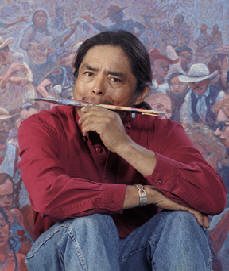Among the many journeys I’ve taken, I have to say that being in the ranks of the National Park Service as a naturalist/ranger tops the list. In all, I spent 10 years in various parks in the American west. A stint in the Tetons in northwestern Wyoming was glorious and adventurous, as was my time on the South Rim of the Grand Canyon in the late 1970s and teaching intercultural interpretation at the Albright Academy later in the ’80s. Capping off the Park Service decade at Navajo National Monument near Shonto was very apt for me.
I knew then, as I know now, that I was one of the fortunate ones. The Park Service uniforms were very cool. I enjoyed these years tremendously as we raised four wonderful kids who were blessed by both the beauty and the journey. These were the times that I learned to be “native” again through the shared mission of preservation and respect for the land and the history and culture of the people. The Park Service and I shared a basic creed: protect and preserve for all future generations. This philosophy brought me home. I tried to instill these lessons with my family, the traveling public and, most importantly, myself.
The years as a civil servant allowed me to see anew through old lenses. I felt beautifully isolated from the ills of the world, its troubles and societal woes. The job description placed me on the edge of canyons holding colors. It placed me at the foot of mighty pristine mountain ranges and gave voice to ancient Anasazi cliff dwellings. I knew I was where I was supposed to be—in constant awe.
Life in these idyllic places certainly had strife. There was plenty, but the tonic to soothe those moments was right there within our visions. I believe the sanctity of such places makes one aware of the frailty of our species and the power of the greater cosmic puzzle. We are a small yet integral part of that cosmos. “You are no less nor greater than the tiny ants scurrying about their mounds, nor the mountains piercing the clouds. We are just a part of this holy creation, an important part. To disturb a piece is to disturb it all,” my grandmother, Bessie, used to say to me.
With these beautiful visions and wonderful colleagues, I had no problem spending my time carrying out the Park Service’s mission. It couldn’t get any better—being in uniform, being native and dispensing information. Between directing people to the right trail and pointing out restrooms, we remained lighthearted and full of smiles. The medicine of laughter and the paradise that surrounded us were my choice of head trips.
A visitor to Navajo National Monument once asked me why the ancient Indian had built their cliff dwellings so far off the road. I said because they did not want their kids run over by RVs. I was asked where they could see real Indian dances and I told them to come out to the Million Dollar Cowboy Bar dancehall—come Saturday night and see me dance. I was even asked once for a Cherokee love secret. “Wrong tribe,” I responded. One out of every seven visitors seemed to posses that great lineage of Cherokee princesses. I warned them about the blood-sucking mosquitoes that might draw out their blood quantum. Mosquitoes do not know if they become “Cherokee.”
Then there are always the new agers. Now and then, we had fun at their expense. Our fun was never out of meanness though. I remember being at a very busy information desk at Colter Bay Visitor Center in Grand Teton National Park, Wyo., one afternoon in July 1979. A couple came up and asked me to settle a dispute. The wife thought “the white stuff on the high mountain” was snow. The husband thought it was the color of the rock. After answering that for the umpteenth time, I could not help it. I said they were both wrong. It was glacier ice, but I said it was Styrofoam, laid there for the climbers’ safety and mandated by OSHA. The couple disappeared into the crowd before I could correct myself.
Oh, the glory days! Without question, these were learning years for me. I recommend the experience to all.

